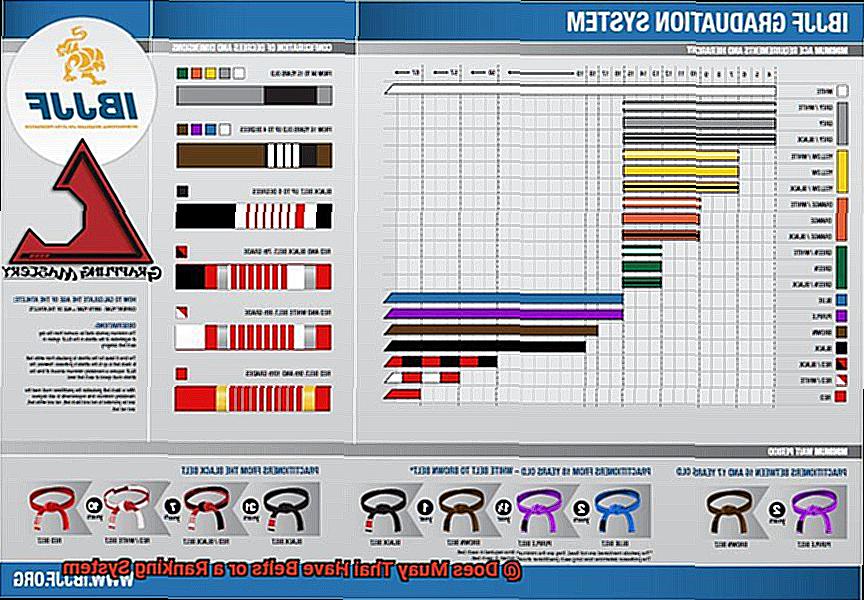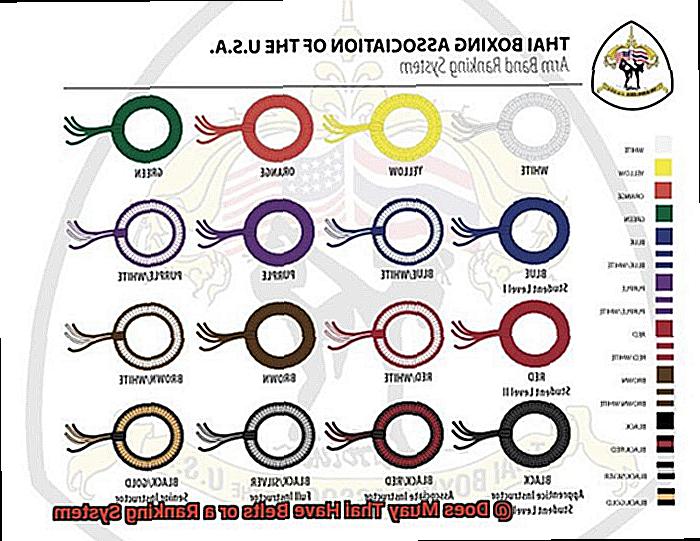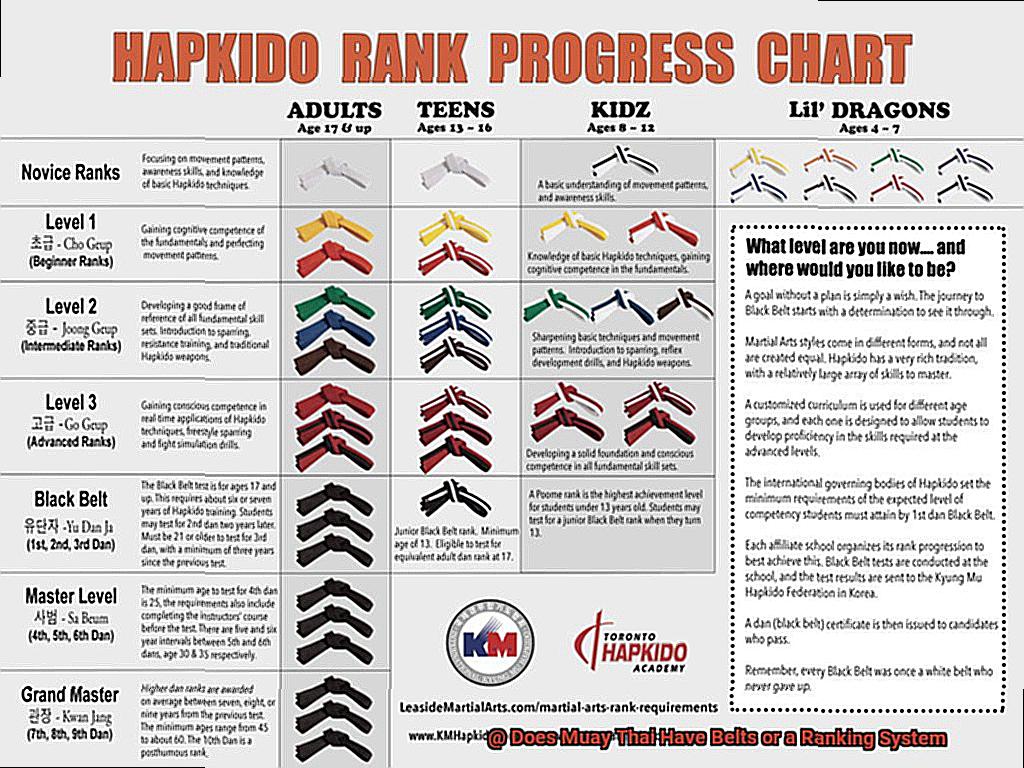Are you curious about the world of martial arts and their ranking systems? If so, you might be wondering whether Muay Thai has a belt system or a ranking system. Known for its aggressive style and efficient techniques, Muay Thai is one of the most popular martial arts in the world. However, unlike other martial arts such as Karate or Judo, Muay Thai does not have a formal belt or ranking system.
Some may find it strange that Muay Thai doesn’t have a belt system since belts and rankings are often used to show progress in martial arts. Instead, progress in Muay Thai is measured by experience gained through fighting in the ring. As a sport, fighters compete against each other at various levels, and wins and losses determine their progress and level of experience.
But why doesn’t Muay Thai have a belt system? What are the benefits and drawbacks of this approach? And how do fighters measure their achievements? In this blog post, we’ll explore these questions and provide a comprehensive guide to the ranking system (or lack thereof) in Muay Thai. Get ready to discover the unique and exciting world of this ancient martial art.
The Khan System of Ranking in Muay Thai
Muay Thai is more than just a martial art. It’s a way of life that demands discipline, perseverance, and dedication. And if you want to prove your worth in this sport, you’ll need to know about the Khan System of Ranking in Muay Thai.
Originating in Thailand, the Khan System is a traditional ranking system that classifies and identifies a fighter’s skill level in Muay Thai. It’s divided into ten levels, represented by different colored armbands. Starting with the white armband, fighters earn their way up to the prestigious gold armband by passing a set of rigorous tests that cover every aspect of Muay Thai – from techniques and sparring to conditioning.
But earning each Khan grade isn’t easy. It requires a high level of skill and dedication to prove yourself in front of a qualified instructor or examiner. And for those who do reach the higher levels, they’re considered experts in Muay Thai – often becoming instructors themselves.
The Khan System is a respected and widely recognized ranking system throughout the Muay Thai community. It provides fighters with a clear path to progress in their training and gain recognition for their skills. The system also helps to maintain the standards of the sport, ensuring that fighters are properly trained before entering the ring.
And while tournaments and competitions may recognize fighters’ accomplishments and skills in the sport with titles such as champion or contender, it’s the Khan System that carries official rank and status within the martial arts community.
Benefits of the Khan System
The Khan System of Ranking could be the answer you’ve been searching for.
Originating from Thailand, the Khan System is a traditional ranking system that measures one’s level of proficiency in Muay Thai. By mastering a set of techniques and knowledge, students can progress through a series of levels and achieve a higher level of mastery.
Firstly, the Khan System provides students with a sense of accomplishment as they progress through each level. Each level has its own set of techniques and knowledge that must be mastered before advancing, ensuring that students have a solid foundation and are well-rounded in their skills. This allows students to set achievable goals and track their progress, giving them a clear sense of direction and purpose in their training.
Secondly, instructors benefit from the standardized curriculum provided by the Khan System. All students learn the same techniques and progress at the same rate, allowing instructors to easily evaluate their students’ progress and identify areas where they may need additional training. This ensures that all students receive the same quality of instruction and have an equal opportunity to succeed.

Additionally, working towards Khan levels creates a sense of community among students. They work together towards their goals, encouraging teamwork and camaraderie. This creates a positive learning environment and helps students stay motivated in their training.

The Khan System is an excellent way to measure one’s level of proficiency in Muay Thai. Whether you’re a beginner or an experienced fighter, it provides clear goals and a structured curriculum that will help you achieve your goals and become an expert in Muay Thai.

Variations of the Khan System
The Khan System, also known as the “Muay Thai Belt System,” is a prevalent ranking system used in Muay Thai to measure a practitioner’s proficiency. But did you know that the Khan System has different variations used in various countries and gyms? Let’s dive deeper into the different Khan System variations and how they are utilized.
The traditional Khan System in Thailand comprises ten levels, starting from the beginner level (white khan) to the master level (black khan). Each level has a distinct set of techniques that a student must learn and master before proceeding to the next level. This system is widely accepted in Thailand as the standard for measuring a student’s progress in Muay Thai.
However, in other countries such as the United States and Australia, the Khan System has been modified to include additional levels and colors of belts. Some gyms use a twelve-level system that includes intermediate levels between each khan level. Others have added new belt colors such as green and brown to signify progress between khan levels.

It’s worth noting that while some gyms use a belt system, not all Muay Thai schools use rankings or belts to measure progress. Some schools prioritize personal growth and improvement over attaining a specific rank or belt. Therefore, if you’re looking for a school that uses the Khan System, ensure you research thoroughly and find one that aligns with your goals.
Titles Earned Through Tournaments and Competitions
The sport offers a ranking system that allows athletes to earn titles through tournaments and competitions, providing a clear path for advancement and recognition within the community.
At the top of the hierarchy is the Lumpinee Championship Belt, a title awarded to the winner of the Lumpinee Stadium Championship. This competition, held twice a month in Bangkok, Thailand, is considered the most prestigious in the world of Muay Thai. But this is just one tournament where athletes can earn recognition. Other competitions, such as the Rajadamnern Stadium Championship Belt and the Omnoi Stadium Championship Belt, offer equally valuable titles that are highly respected within the sport.
However, it’s not just about winning these championship belts. There are also rankings within weight classes based on an athlete’s performance in competitions – wins, losses, and level of competition all factor into these rankings. These rankings provide insight into an athlete’s skill level and potential for future success.
The ranking system in Muay Thai promotes healthy competition and encourages athletes to strive for excellence. It fosters a sense of community and camaraderie among practitioners who share a passion for the sport.
For those looking for a challenging and rewarding experience, Muay Thai offers a clear path toward recognition and advancement.
Comparison to Other Martial Arts Disciplines
While it’s true that Muay Thai does not have a belt system like Karate, Taekwondo, or Judo, this doesn’t mean that there is no way to determine a student’s level of proficiency in the sport.
Unlike traditional martial arts that originated in Japan and Korea, Muay Thai is a combat sport that originated in Thailand. The ultimate goal for fighters is to earn championship belts through tournaments and competitions, rather than progressing through colored belts. The highly respected Lumpinee Championship Belt is the pinnacle of success in Muay Thai.
However, Muay Thai does have a way of classifying fighters based on their experience and skill level. Fighters are ranked as novice, intermediate, advanced, and professional based on the number of fights won and their ability to perform certain techniques. This classification system helps fighters understand where they stand and what they need to improve on to climb the ladder of success.
In contrast, traditional martial arts like Karate and Taekwondo use colored belts to motivate students to work hard and progress towards higher levels. The belt system helps instructors identify the skill level of their students and plan their training accordingly.
Judo is another traditional martial art that has a belt system similar to Karate and Taekwondo. Brazilian Jiu-Jitsu, a modern martial art that originated in Brazil, also has a ranking system that includes colored belts with black being the highest rank.
It’s important to note that Muay Thai and Brazilian Jiu-Jitsu are fundamentally different in terms of their focus and techniques. While Brazilian Jiu-Jitsu emphasizes grappling and ground fighting techniques, Muay Thai focuses on striking techniques like punches, kicks, knees, and elbows.
BXtbU6SY8-I” >
Conclusion
In conclusion, Muay Thai stands out among martial arts for its unique approach to measuring progress. Instead of using belts or a traditional ranking system, Muay Thai relies on experience gained from competing in tournaments and championships. However, the Khan System provides a structured curriculum with ten levels that measure proficiency using white to gold armbands.
The Khan System not only helps students set achievable goals but also fosters a sense of community among practitioners. It allows instructors to evaluate their students’ progress effectively while promoting healthy competition and encouraging excellence. While variations of the Khan System exist across different countries and gyms, each school decides whether or not to implement a ranking system and how it is structured.
Compared to other martial arts like Karate, Taekwondo, Judo, and Brazilian Jiu-Jitsu, Muay Thai focuses on striking techniques. Nonetheless, it shares the same values as traditional martial arts disciplines such as promoting personal growth through hard work and dedication.






